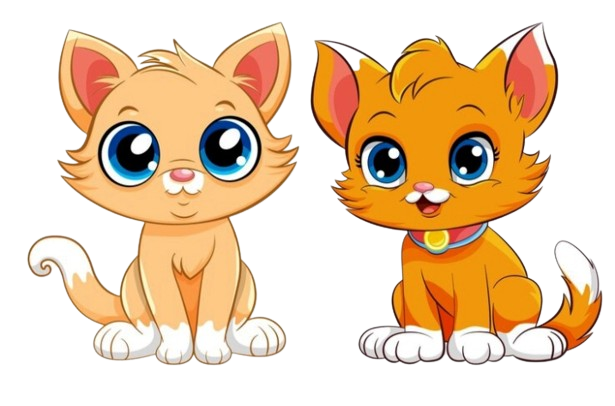Scottish Straight Cat (Scottish Straight)
Scottish Straight Cat
Scottish straight cat, in fact, is a kind of Scottish fold, having all the character traits and external features. The only difference is the lack of folded ears.
Accordingly, speaking about the origin of the Scottish Straight, we can say that their pedigree comes from a white cat with floppy ears named Susie, who was born in Scotland, in 1961, near the town of Copra Angus. The farmer, who had such offspring on the farm, was extremely interested in folded ears.
Now everyone knows that such a structure of the ears comes from a genetic mutation, moreover, this mutation affects not only the ears, but can also affect other body systems. But in those distant years, research has not yet been carried out, and the cat very quickly gained popularity due to its extraordinary appearance.
However, even now, despite possible health complications, both the Scottish Fold and the Scottish Straight, which some Federations classify as one breed, are a huge success all over the world.
There is one feature - when crossing two lop-eared individuals, the probability of getting a cat with straight ears is extremely low, but the probability of mutations is higher. Conversely, if one of the parents has straight ears, the likelihood of mutations is almost eliminated, and the offspring will almost certainly also have straight ears.
Characteristics of the breed
Adaptability 10/10
Attachment to family 10/10
Game activity 06/10
Intelligence 07/10
General Health 09/10
Hair loss 04/10
Child-friendly 08/10
Dog friendly 10/10
Love of Meows 02/10
Information about the breed
|
Country
of origin |
Scotland |
|
Lifespan |
12-15
years old |
|
Size |
medium |
|
Weight |
Cats:
5-6 kg, Cats: 3-5 kg |
|
wool
type |
shorthair |
|
Color |
any
colors and coat patterns |
|
Lifestyle |
outdoor/indoor |
|
Price |
1000 -
1500 $ |
Description
Scottish Straight - kind and loving cats, incredibly sweet
and affectionate, have great charm, and captivate literally everyone. Life
expectancy is on average about 15 years.
The body and paws are short and strong, the head is shortened, and round, and the neck is also short, as are the ears. On the muzzle, as if you
can always see a smile. There are many possible colors, each with its own
aesthetic. There are individuals with multi-colored eyes (orange and
blue), although, traditionally, this breed has orange eyes.
By the way, Scottish Straight at a young age lends itself
well to training (given that it is extremely difficult to train cats in
general), and they are often trained to perform at exhibitions.
Personality
The Scottish Straight cat has an incredible charm and is
able to conquer even those who, as usual, are rather indifferent to
cats. These are very affectionate and kind animals that get along well in
the family and are able to bestow their love on each of its members. Scottish
Straight has a pronounced intellect, are able to draw conclusions, and observe
what is happening around them, sometimes from a secluded place. This is what
happens when you have guests. However, in its circle, the cat more often
chooses the knees of a loved one.
The Scottish Straight can be a great friend to children,
although, like most cats, these pets do not like to be squeezed too
much. Cats of this breed retain playfulness even in adulthood, and in
general, mature for quite a long time. If you have other pets at home - it
does not matter, the Scottish Straight gets along well with everyone. An
exception can only be dogs that show aggression.
These cats are neat, do not spoil upholstered furniture, and
learn quickly. At the same time, they are quite active and inquisitive,
they are interested in what is happening around them. They feel great in
solitude, but they will not feel discomfort in the company. This applies
to both kittens and adults.
Common diseases
Cats, in general, do not tend to get sick, and have good health,
but are prone to “pedigreed” diseases.
The gene responsible for unusual ears also affects other
parts of the skeleton. There is also a particular propensity for joint
problems:
- osteochondrodysplasia;
- chondrodystrophy;
- arthritis;
- arthrosis.
Even though it is traditionally believed that crossing a
Fold with a Straight can protect a pet from such problems, this is not the
case.
Due to the shortened shape of the head, it can lead to
brachycephalic syndrome - respiratory failure.
Also, there is a tendency to suppuration and inflammation in
the eyes, due to their special shape.
Care
One of the easiest breeds to keep is the Scottish
Straight. Caring for them does not take much time, but, at times, requires
vigilance due to possible problems with the eyes and breathing. If you
experience difficulty in breathing or inflammation in the corners of the eyes,
it is best to contact your veterinarian immediately.
Otherwise, the cat is unpretentious - once a week you need to trim the claws, clean the ears several times a week, teeth - better every day, like the eyes. Be sure to make sure that your pet has favorite toys so that he maintains a normal level of activity, does not pass on, and eats quality food. Bathing - at least once a month.
.jpg) |


.jpg)
.jpg)
.jpg)
.jpg)
.jpg)
.jpg)
